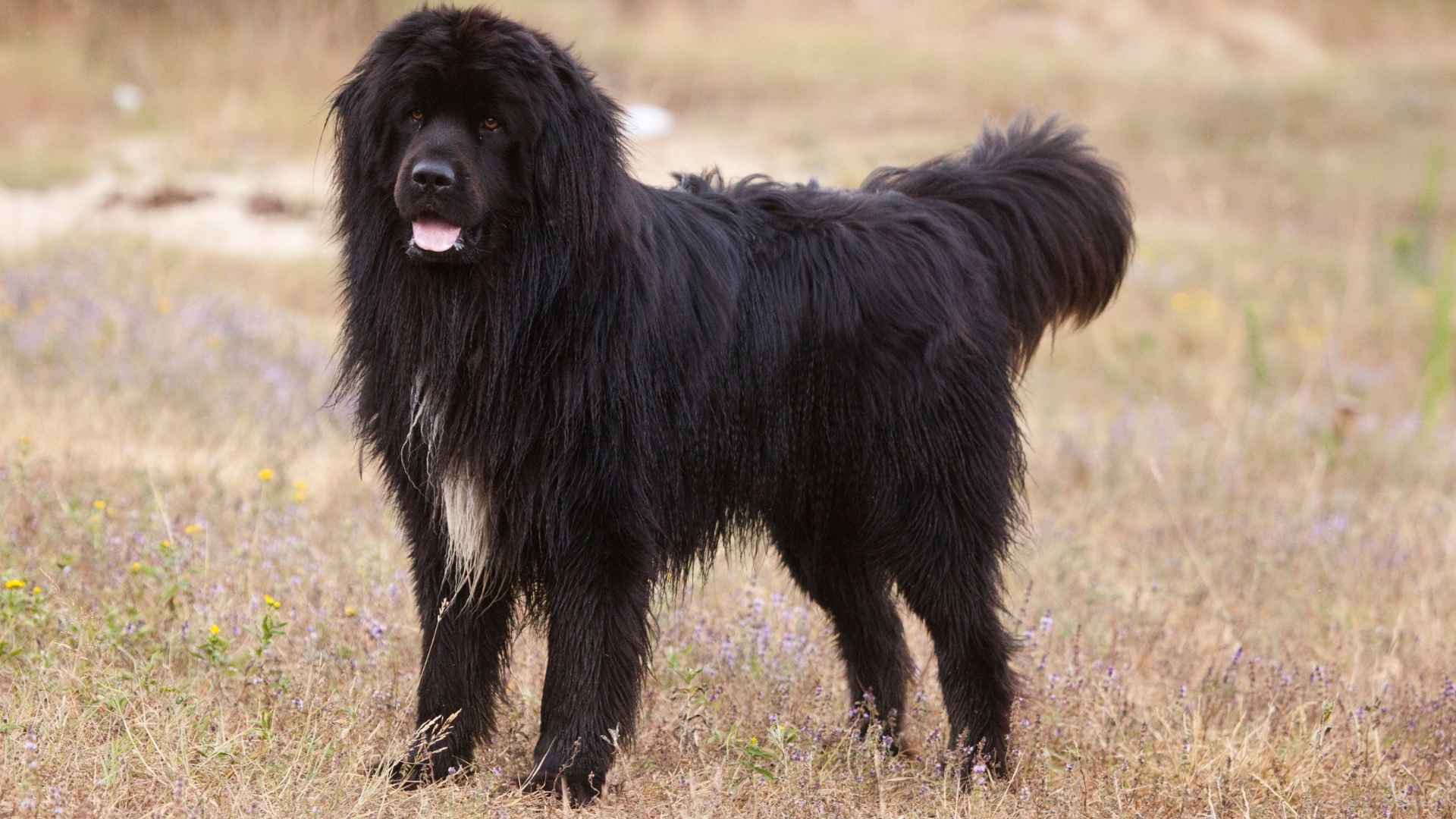Looking to meet the real heavyweights of the dog world? You’re in for a treat! The many large dog breeds aren’t just big—they’re massive, majestic, and full of heart. From the towering Great Dane to the fluffy yet formidable Saint Bernard, these gentle giants come from all over the world, bred for strength, stamina, and a dash of drool.
Sure, they may take up half your couch (and all of your heart), but big dogs bring big love—and even bigger personalities. Over time, humans have shaped these breeds for everything from guarding castles to rescuing travelers in snowstorms.
While their size might seem intimidating at first, most are sweet-natured snugglers who just want belly rubs and a bit more room to stretch out. If you’ve ever wondered what it’s like to share your life with a dog that weighs more than you do, stick around—we’re diving into the world of the heaviest dog breeds!
Heaviest dog breeds
1. English Mastiff

Say hello to the heavyweight champ of the dog world—the English Mastiff. Towering at around 30 inches tall and weighing anywhere from 160 to 230 pounds (with females not far behind), these pups are massive in every sense of the word.
Think living ottoman with a heartbeat. While their average lifespan is only 6 to 10 years, every slobbering minute is worth it.
Mastiffs have roots stretching back to ancient times, once facing lions in Roman arenas and serving in wars. Thankfully, today’s version is far more chill, preferring Netflix and nap marathons to battlefield brawls.
Despite their size, Mastiffs are famously sweet, gentle, and loyal. They adore their families, are usually great with kids, and often believe they’re lap dogs—until gravity says otherwise. Their calm, steady nature makes them excellent companions in the right home.
Now for the fine print: Mastiffs drool—a lot. One good shake can redecorate your walls. Add in epic snoring and some impressive flatulence, and you’ve got a dog that keeps things interesting. But ask any Mastiff parent—it’s all part of the charm.
Though massive, these dogs aren’t bouncing off the walls. They prefer lounging near their people over intense activity and need space to stretch, not sprint. Most importantly, they thrive on companionship and aren’t suited for long hours alone or outdoor-only living.
Sure, they come with some challenges, but if you’ve got room in your home—and your heart—the English Mastiff offers devotion, affection, and a whole lot of dog to love.
2. Saint Bernard
Say hello to the lovable snow bear of the dog world—the Saint Bernard! Originally from the snowy Swiss Alps of Switzerland, these gentle giants once roamed the mountains as legendary rescue dogs. These days, they’re more into snuggles than search missions, acting like oversized, fuzzy therapists who also double as heaters for your feet.
Saint Bernards are unmistakable: giant heads, soft brown eyes, droopy ears, and those iconic wrinkled brows that make them look like they’re always deep in thought, probably about snacks. Males can reach up to 30 inches and 180 pounds, with females a bit smaller but still impressively hefty.
Despite their heroic history, Saints are total couch potatoes. They’d rather sprawl out in a cool spot than chase balls or bark at the mailman. They’re sweet with family, chill around guests, and usually do fine with other pets, as long as nobody asks them to hustle.
That said, early training is important. When you’ve got 150 pounds of love barreling toward your couch, manners matter. They’re not built for jogs or heat, but give them snow and they’ll be in heaven. They’re calm, not clumsy, but their size alone means a little guidance goes a long way.
And yes, there will be drool. A Saint Bernard’s head shake can turn your living room into a splash zone. But for those who don’t mind keeping a towel nearby, these sweet, soulful giants offer enough love to warm even the frostiest day.
3. Neapolitan Mastiff
If you’ve ever imagined living with an ancient Roman guardian who looks like a walking, wrinkly blanket, meet the Neapolitan Mastiff. These slow-blinking giants have a sturdy build wrapped in wrinkly skin that could star in Jurassic Park. But beneath that droopy drama lies a gentle giant who’d make a great family dog instead of battle gladiators, though they certainly have the strength if needed.
Bred in ancient Italy to guard estates and turn heads, Mastinos are powerful dogs. Their massive, muscular bodies, short coats, pendulous jowls, and signature wrinkles make them impossible to miss.
American Kennel Club (AKC) describes this breed as “dignified, loyal and watchful” . Mastino is surprisingly mellow housemates—if you can handle the drool and snoring, that sounds like a chainsaw in full swing.
Exercise for these laid-back dogs should be short and sweet—think two 20-minute strolls daily to keep joints happy. Puppies, on the other hand, are all wobbly legs and zoomies; too much roughhousing or stairs can be risky since their bones grow faster than their coordination. A balanced routine keeps them content and safe.
Training takes patience and consistency. Neapolitan Mastiffs are smart but stubborn and don’t fall for just any treat bribe. Positive reinforcement and early socialization are key—teaching them who’s a friend, who’s the mail carrier, and who’s just dropping off pizza helps keep their natural wariness in check.
These dogs aren’t yard guards; they’re family through and through. They crave connection, prefer the couch over isolation, and will happily become a 150-pound footstool during your binge sessions. Loyal, laid-back, and generously drooly, the Neapolitan Mastiff is truly one-of-a-kind.
4. Great Dane
Meet the Great Dane—a towering dog that might make your dining table feel a bit short. Bred in Germany over 400 years ago to hunt wild boars, today’s Dane prefers head pats and couch naps over chasing prey. Despite their huge size, these Danes are calm, affectionate, and surprisingly cuddly.
With a sleek, muscular build and a jawline that could grace a runway, Great Danes sport short coats in striking colors like fawn, brindle, blue, black, and the dramatic harlequin—think Dalmatian meets high fashion. Though their name suggests Danish roots, they’re proudly German, known locally as Deutsche Dogge, according to Britannica.
Despite being a giant dog breed, Danes are as loving as they are goofy, winning hearts with their loyal and playful nature. Just remember: you’ll need plenty of space (and patience) for a 130-pound buddy who truly believes they’re lap-sized.
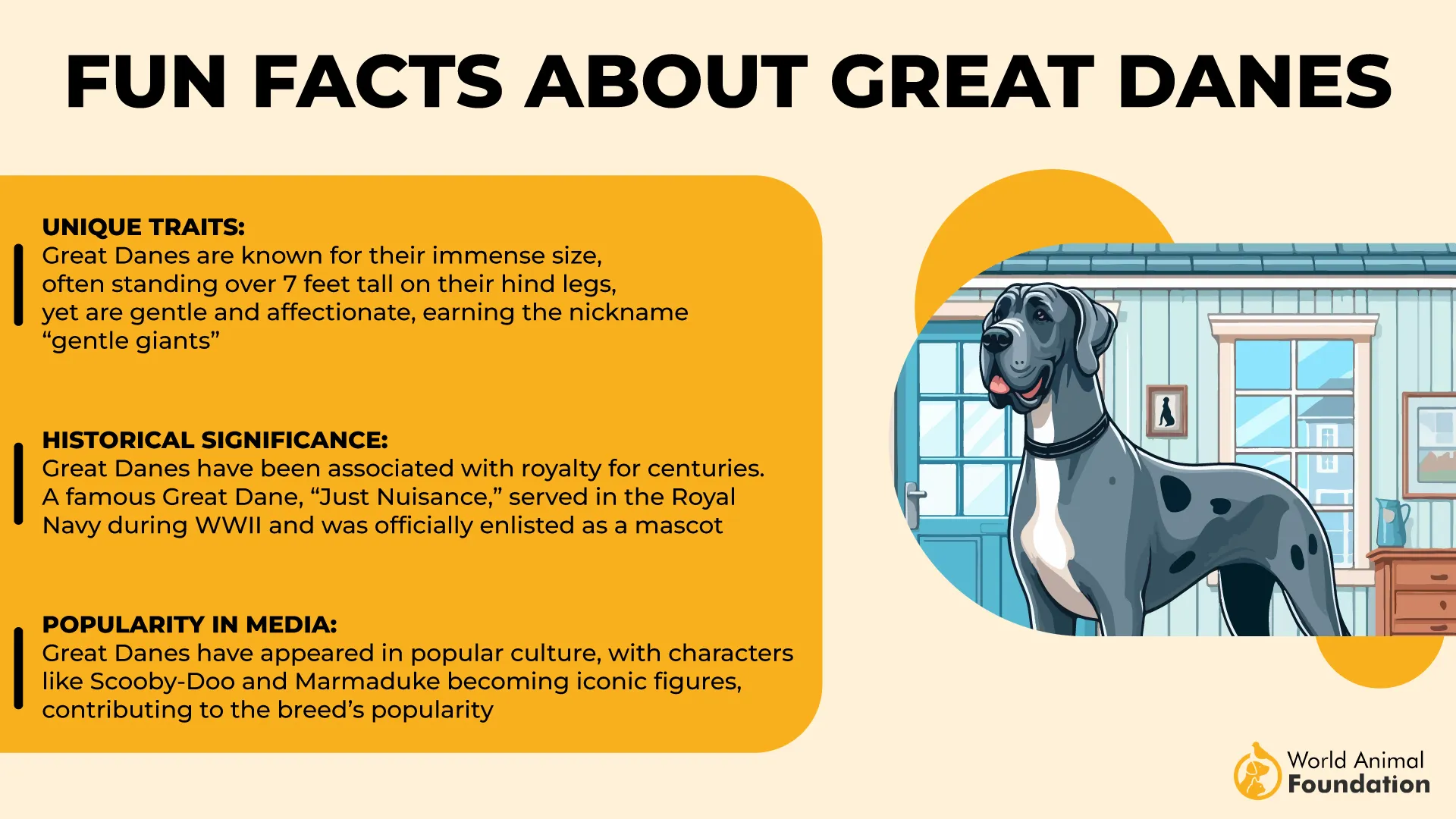
Exercise needs are moderate—about 20 to 40 minutes daily to keep those long legs moving. Grooming is low-maintenance thanks to their short coat, though shedding happens. But honestly, you’ll probably be too busy wiping up drool to notice the hair.
On the health front, Great Danes have shorter lifespans, usually 6 to 8 years, and face risks like bloat, heart issues, and joint problems. Careful feeding—small, frequent meals—and monitoring can help, and some owners even consider preventive surgery to avoid emergencies. Loving a Dane means going all in on their care.
Did You Know?
A Great Dane named Zeus from Texas holds the Guinness World Record as the tallest living male dog at 1.046 meters (3 feet 5 inches). Basically, if he stood on his hind legs, he could probably reach the top shelf—and maybe the moon.
5. Newfoundland
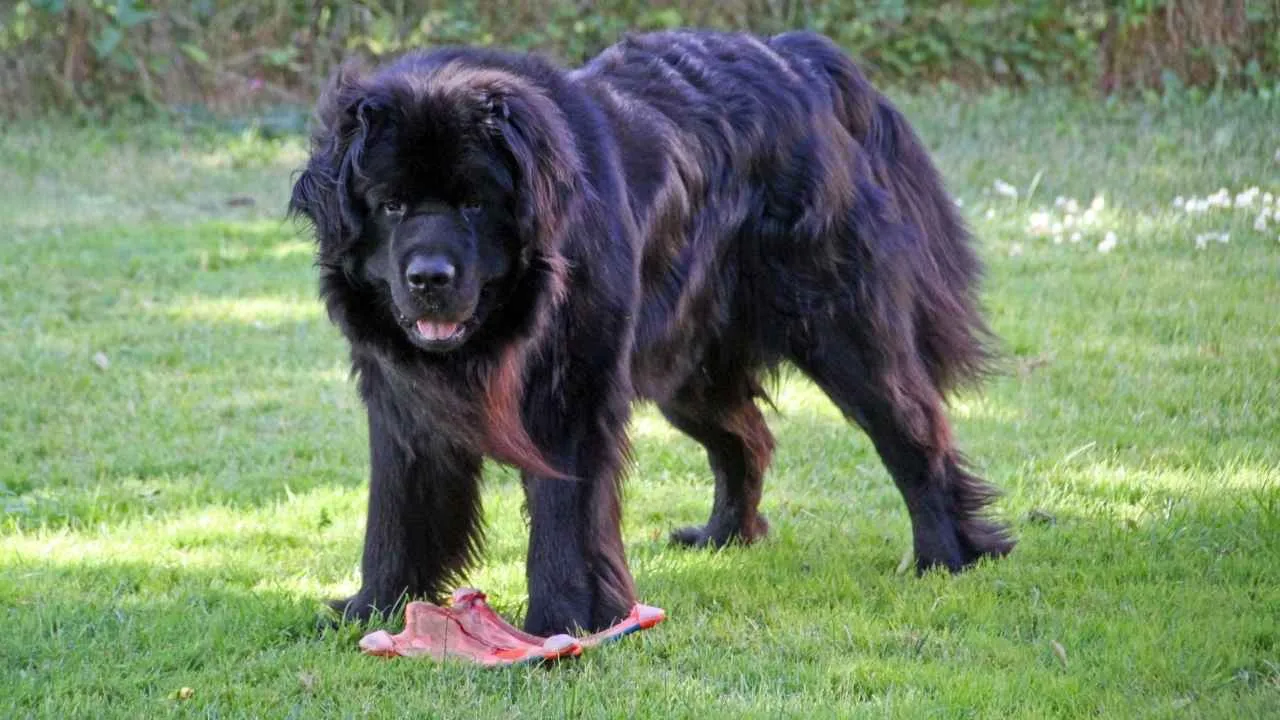
If you’ve ever wanted a dog that’s part lifeguard, part teddy bear, and 100% gentle giant, meet the Newfoundland—also known as the Newfie or the gentle snow plow of the dog world. Originally bred to rescue sailors from icy waters, these water-loving dogs were the unsung heroes of Canadian fishing boats long before it was trendy.
Newfies are impressively large, with males tipping the scales around 150 pounds and standing nearly 28 inches tall. Females are slightly smaller but still hefty. Their thick double coats come in solid black, grey, chocolate, or the striking white-and-black “Landseer” pattern.
Add soulful brown eyes and a head big enough to rest your cup of tea on, and you’ve got a great companion for yourself.
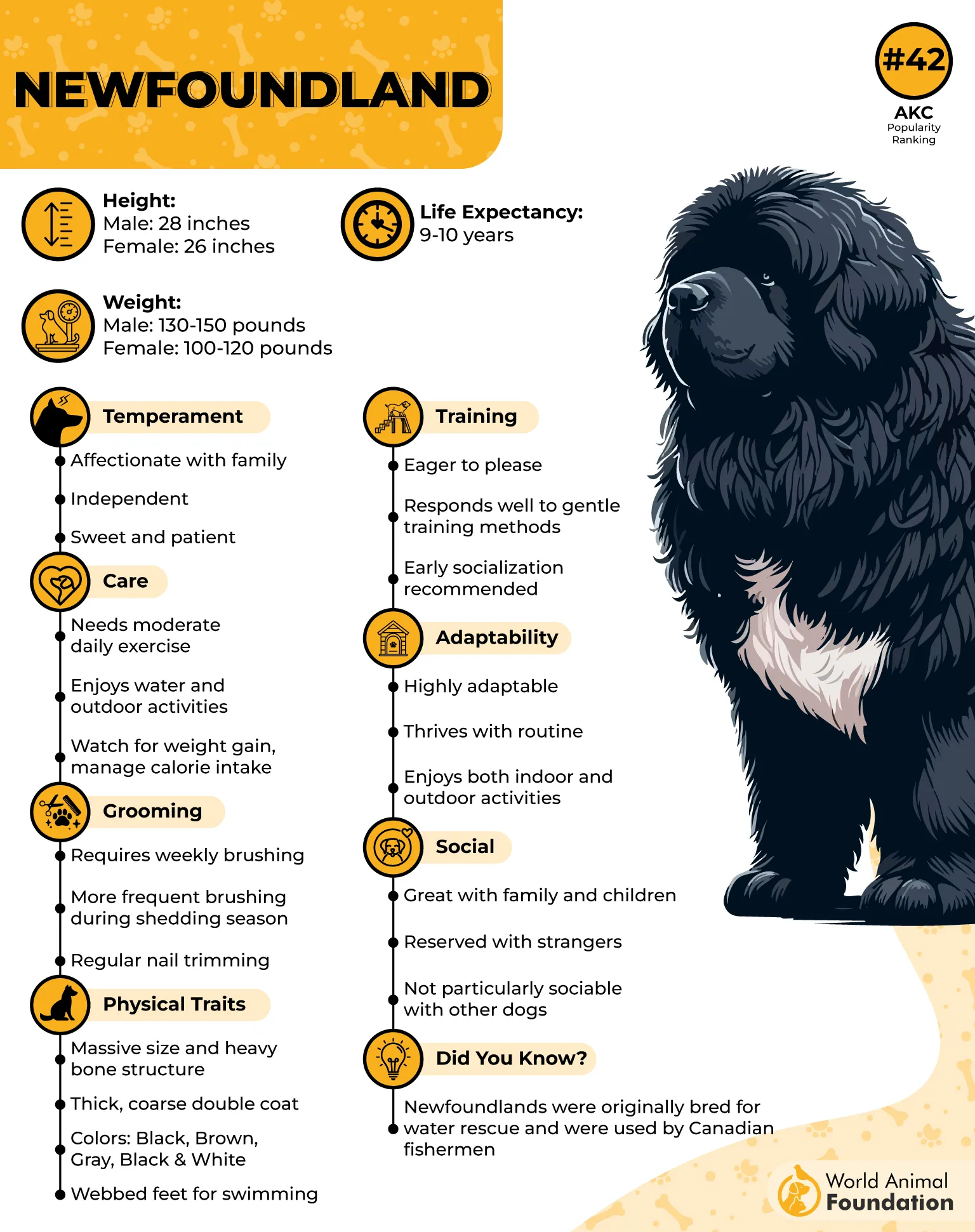
Built for cold water rescue, Newfies have water-resistant coats and webbed feet that make them excellent swimmers. While they may no longer work at sea, many still love swimming. After a good walk or swim, they happily settle in as oversized, fluffy couch potatoes.
Known for their kind, patient, and intuitive nature, Newfies are especially great with kids and other pets and are even nicknamed “nanny dogs,” states WebMD. They’re gentle watchdogs, more likely to greet visitors with a friendly bark than a growl. Give them love, and you’ll get a devoted 120-pound cuddle companion in return.
Despite their massive size, Newfoundlands adapt well to home life. They’re calm and quiet, needing just a bit of daily exercise and yard time to stay content. But watch the snacks—these laid-back giants can pack on the pounds if they lounge too much without enough activity.
Fun Fact:
Back in the 1930s, a Newfoundland named Swansea Jack became a real-life legend after saving up to 27 people from drowning off the coast of Wales. The locals were so impressed that they built him a monument and named him “Dog of the Century.”
6. Leonberger
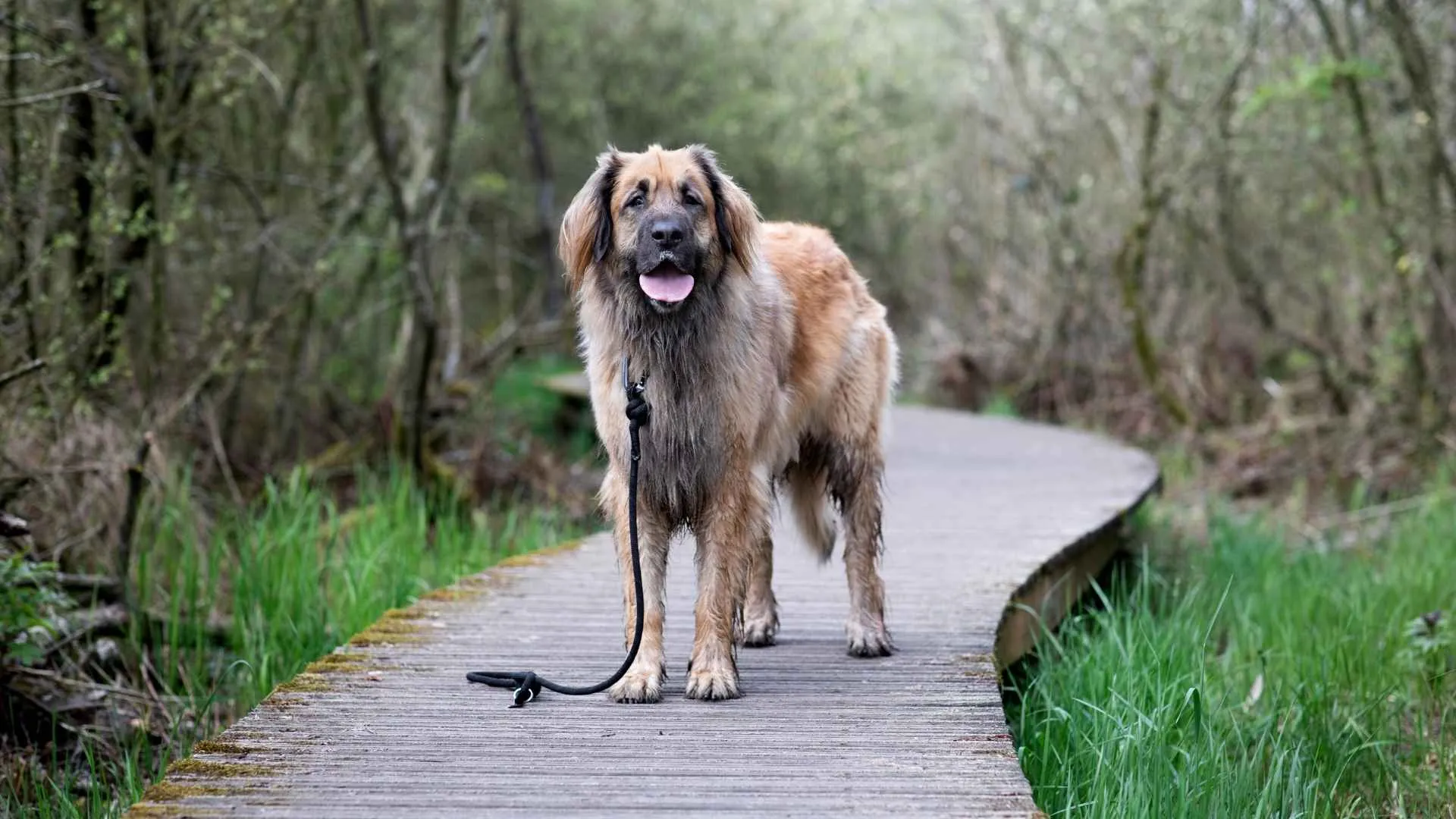
Meet the Leonberger—a majestic blend of Saint Bernard, Newfoundland, and Great Pyrenees, sporting a lion-like mane and an even bigger heart. This German-origin working dog breed looks ready to guard a castle, but behind that regal black mask is a total sweetheart who just wants to chill with you, preferably on the couch.
Males stand over 31 inches tall and can weigh close to 170 pounds. Despite their size, Leos move with surprising grace, their elegant, flowing gait captivating to watch. Their thick, water-resistant double coat comes in warm mahogany, red, and golden-brown hues, complete with a built-in scarf of a mane and those signature floppy ears.
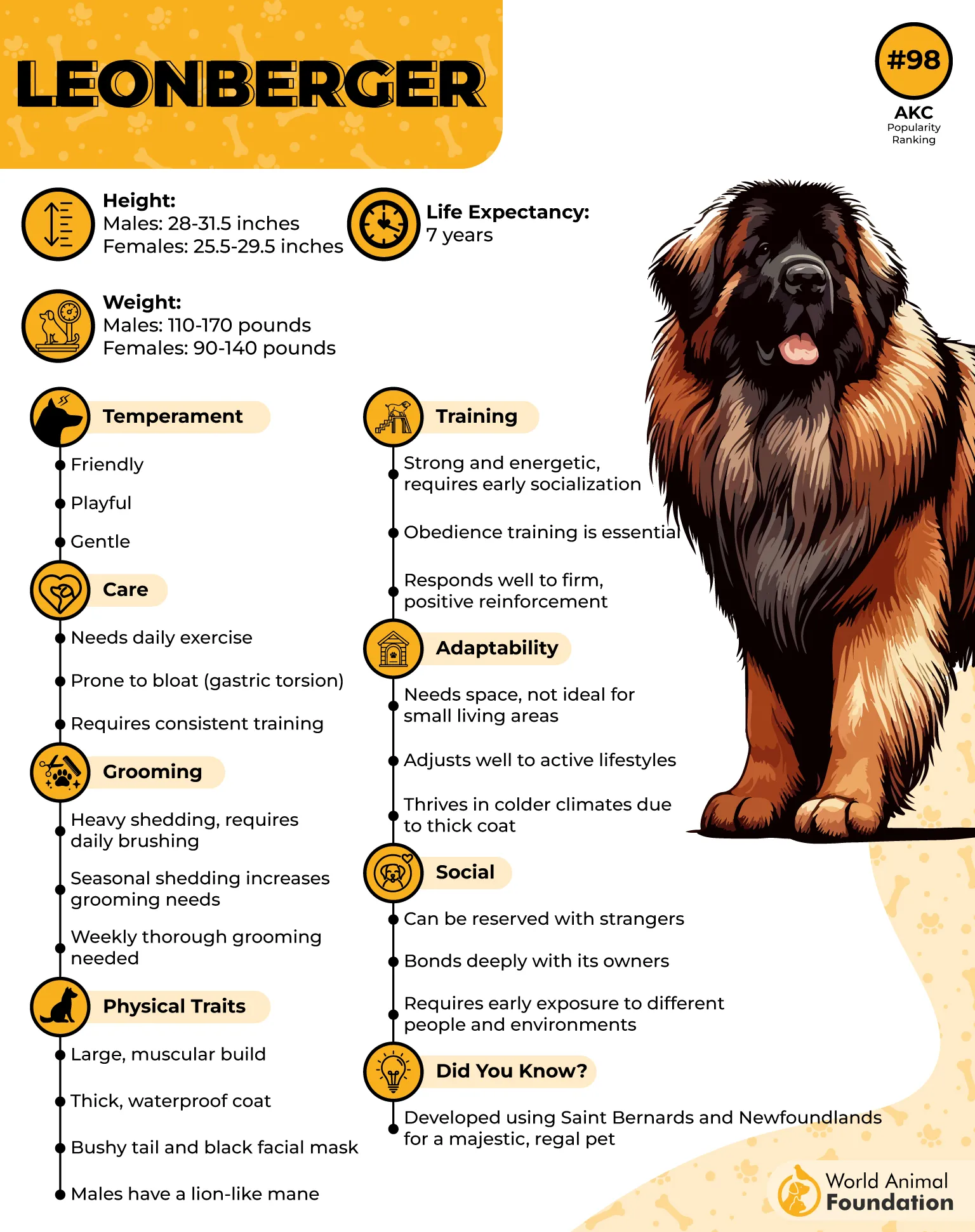
Don’t be fooled by their size—Leonbergers are calm, intuitive, and incredibly tuned into their people’s emotions. Whether you need comfort or a cuddle buddy, they’re there, radiating warmth like a giant weighted blanket. It’s no surprise they’re often chosen as therapy and rescue dogs.
They thrive in the heart of family life. They adore children and are famously patient, though supervision is wise during playtime due to their size. Early training is essential to help them grow into calm, respectful companions who handle strangers and other pets with ease, though they might need guidance around dominant dogs, states PetMD.
Yes, they shed and require regular brushing (and probably a vacuum with superpowers). But in return, you get a loyal, affectionate companion with a noble spirit who’ll easily steal your heart—and maybe your spot on the couch.
7. Irish wolfhound
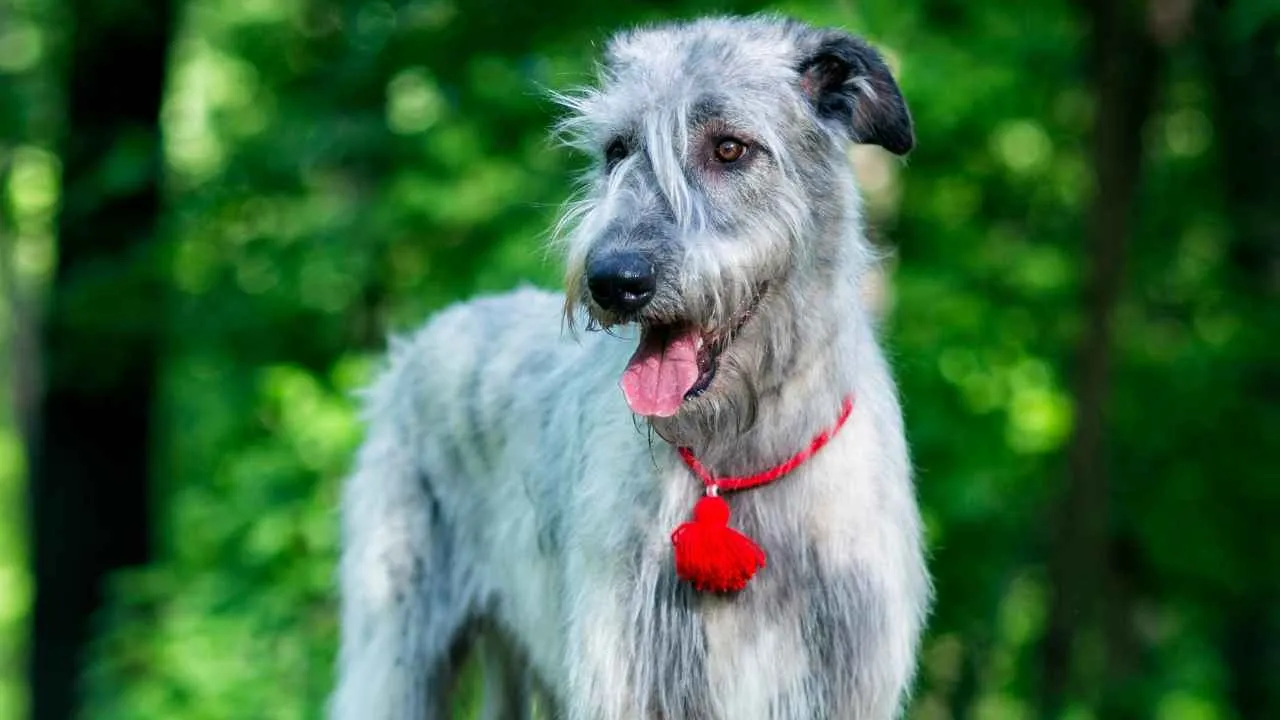
The Irish Wolfhound is the tallest dog breed, standing a stunning 32 inches at the shoulder, and some can even reach 7 feet tall on their hind legs. They’re basically a small horse wrapped in a giant, fluffy cuddle machine.
These gentle giants have a heroic past. Once fierce warriors hunted wolves, elk, deer, and wild boar, and nowadays, they’ve swapped battlefields to be family pets to enjoy belly rubs and backyard naps.
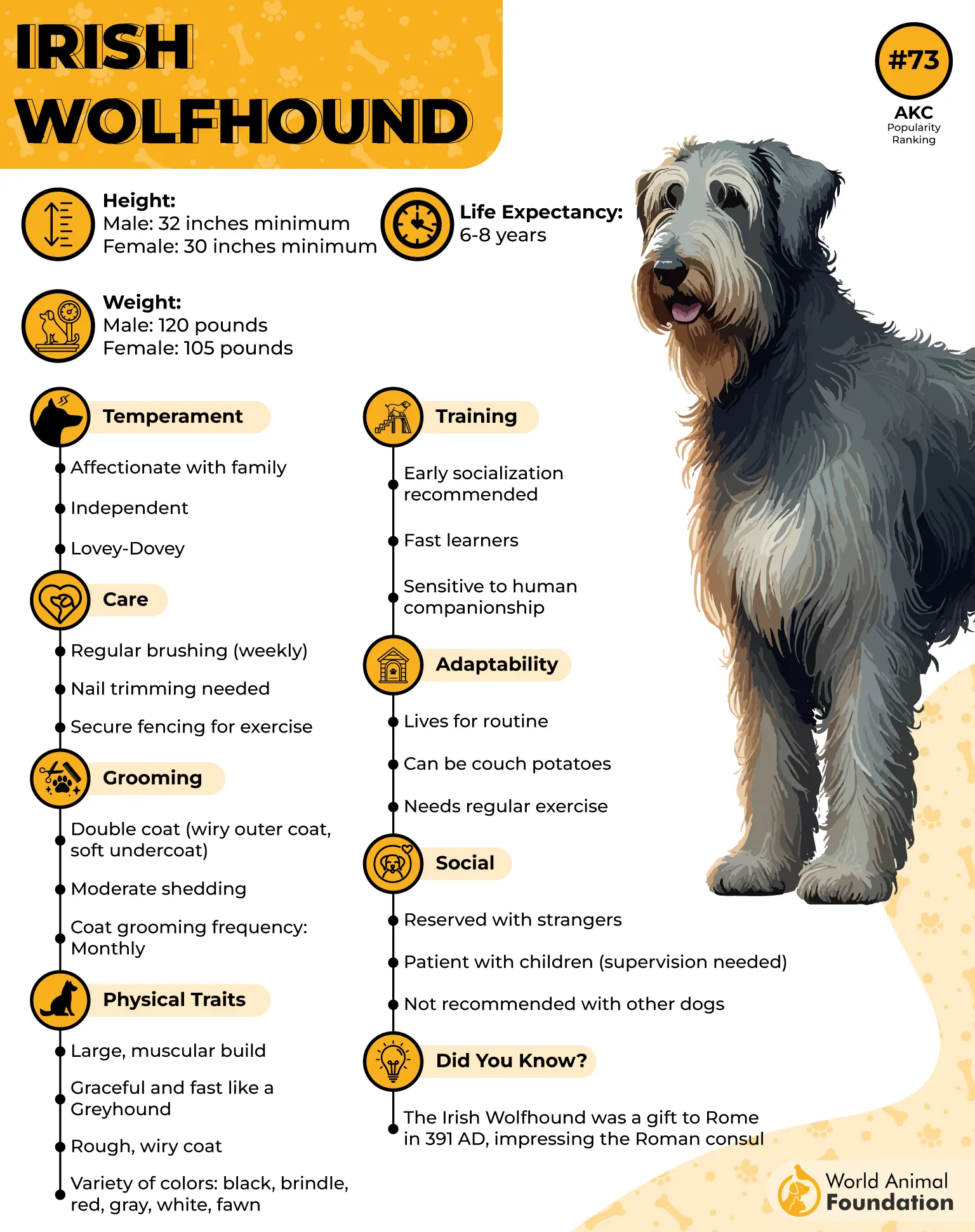
Despite their impressive size and being the tallest dog breed, Irish Wolfhounds are total softies. Not exactly guard dogs—they’re more likely to greet strangers with a wagging tail than a growl. Loving and patient, they’re great with kids and happy to lounge around, especially if that includes hopping on the furniture.
These big-hearted dogs hate being left alone and thrive on close bonds with their humans. While not overly energetic, they do need space and regular walks to keep those long legs moving and minds happy.
On the grooming front, they’re pretty low maintenance and allergy-friendly, thanks to minimal dander. Just be ready for a playful puppy phase that lasts—these jumbo-sized goofballs take their time growing up but keep their zoomies well into adolescence.
Fun Fact:
Legend has it that way back in the day, Irish High King Cormac Mac Airt didn’t just have a squad—he had a whole army of 300 Irish Wolfhounds! Talk about squad goals. These big furry legends were basically the MVPs of hunting, guarding, and being loyal sidekicks all at once. Basically, the ultimate furry dream team!
Conclusion
Wrapping up, the world’s heaviest dog breeds—from the Bernese Mountain Dog to the Dogue de Bordeaux—are more than just impressive in size. These giant breeds are often deeply loyal, immensely strong, and surprisingly gentle, making them incredible family pets when given proper care, space, and socialization.
Whether it’s the protective Anatolian Shepherd Dog, the majestic Pyrenean Mountain Dog, or the regal Tibetan Mastiff, large breed dogs tend to require more food, regular grooming, and more space than smaller breeds—but what they give back in love and loyalty is unmatched.
If you’re considering one of the biggest dog breeds, working with responsible breeders and understanding the specific needs of breeds like the French Mastiff, Scottish Deerhound, or Italian Mastiff is key. These dogs weren’t just built for livestock work or guarding—they’re built for deep bonds, big hearts, and a lifetime of companionship that often outshines other dogs in the best way.


